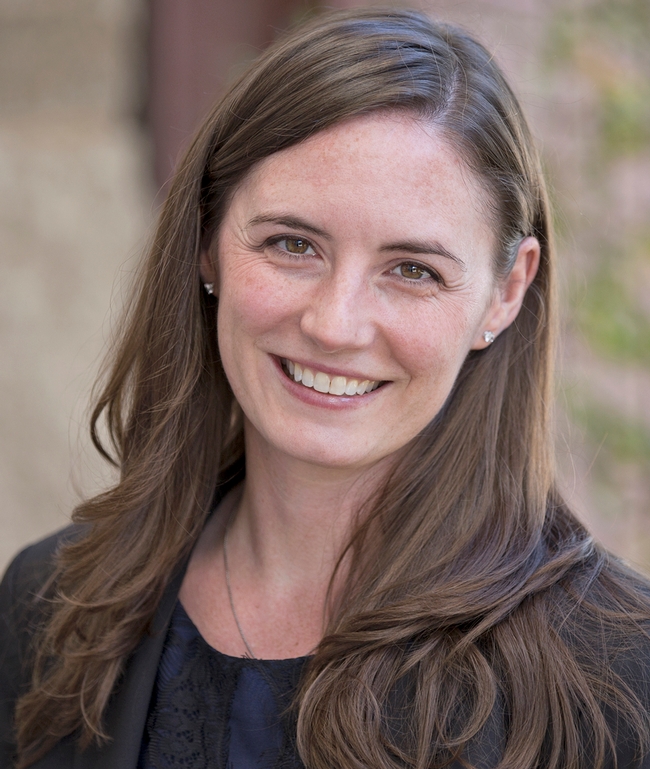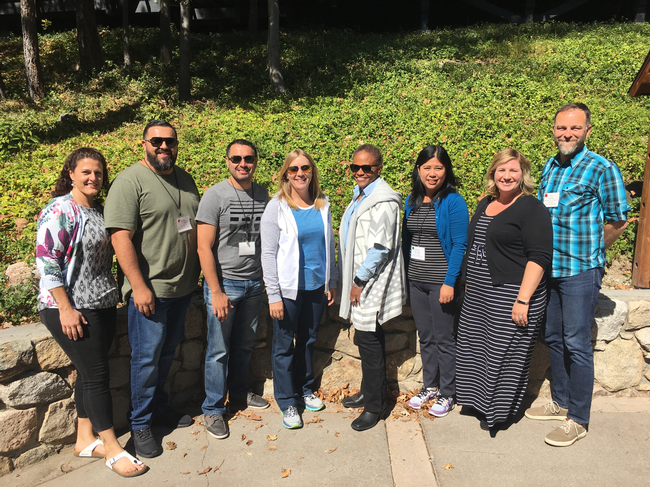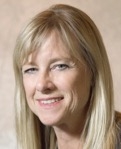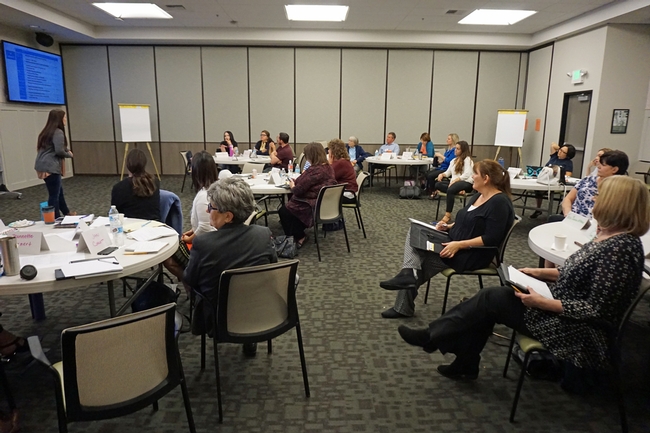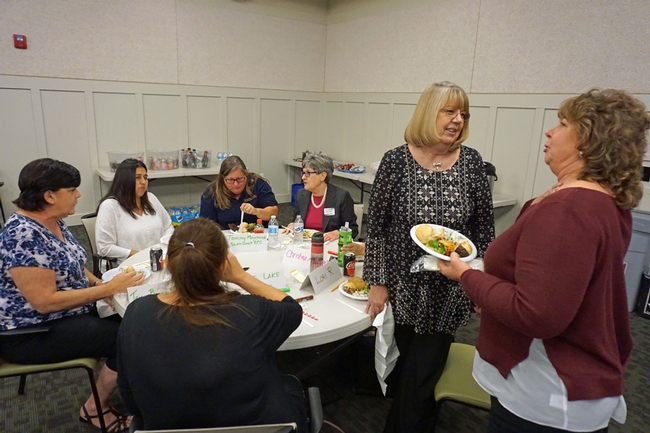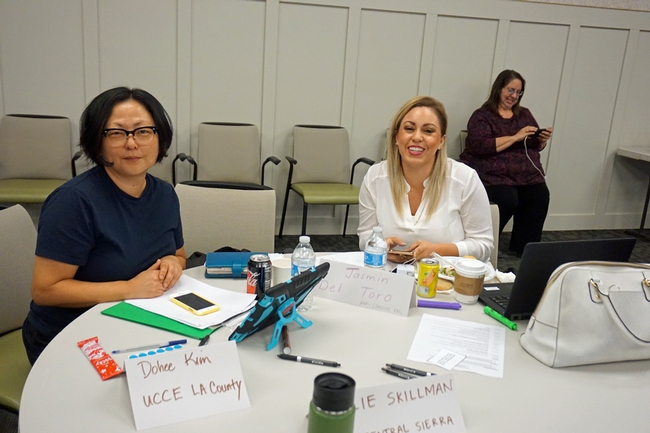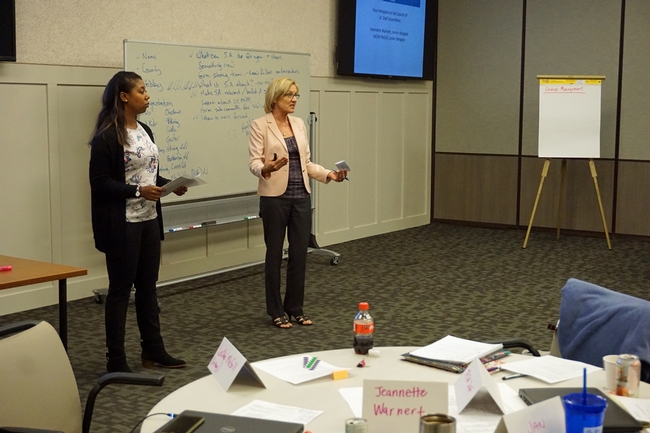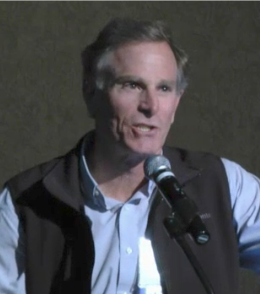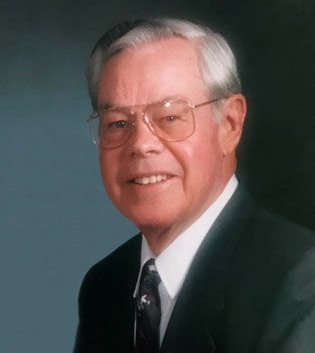Posts Tagged: October 2017
The value of the 5-minute “elevator” speech to share your research with non-scientists
This article was originally published Oct. 20, 2017, in the American Society of Animal Science's Taking Stock D.C. blog https://www.asas.org/taking-stock/blog-post/taking-stock/2017/10/30/guest-blogger-delivers-powerful-message.
Anne Megaro is government and community relations director for the University of California Division of Agriculture and Natural Resources. She helps bench and field researchers spread the good news of their work by “sharing their story” with policymakers and community stakeholders. She earned a Ph.D. in Animal Science from Cornell University and was a 2010-2011 AAAS Science and Technology Fellow.
If you had to explain, in layman's terms, your current research area and the impact of your work on human lives, could to do it? Could you do it in five minutes?
This was one question asked of me during my interview for the AAAS Science and Technology Fellowship, which is a highly regarded and competitive year-long program geared toward Ph.D., M.D., and D.V.M. graduates who are looking to explore what it would be like to work in public policy on Capitol Hill. I like to think that I nailed this question in my interview (“I research milk fat and how it's healthy for people”), but then again, my research was easily translational…. and I had a lot of practice. In graduate school, I was constantly fielding questions from people outside my department who, when they found out I worked with cows, would instantly pepper me with a myriad of questions about milk – ranging from nutrition to hormone use to animal welfare. I loved the fact that every person I spoke to left our conversation knowing a little bit more about food and how it's produced.
What I didn't know then, however, was that these moments were perfect opportunities to reach people outside of the science arena and bring them into the fold, a step closer to understanding a world that seems too complex or foreign to comprehend. Science shouldn't be a black box and research shouldn't be siloed away from the view of – and use by – other professions. The world is increasingly dependent on science to deliver new technologies and research breakthroughs that will expand our knowledge and allow us to continue pursing healthy and prosperous lives.
To break down these silos, we need to learn how to translate science into forms that can be used by other professions, especially those professions that determine public policy. The good news is that there are science-minded legislators and staffers in the halls of Congress and in state capitols. Some have science backgrounds, some are – quite literally – rocket scientists, and some do not have science degrees but are exceptionally intelligent. They will be receptive to hearing about your research and what it will do to transform society. However, they likely won't have an hour to spend with you to discuss your work. At best, a half hour. Most likely, 15 minutes… and your meeting might take place in a loud, crowded, hallway.
Which brings us back to my initial point – the importance of being able to share your research in a five-minute “elevator” speech. If enough scientists stood willing and able to reach out and communicate their science, communicate their expertise, communicate the knowledge it has taken years of hard but exciting work to attain, where would we be? Would there be greater interest and support from Congress for agricultural research? Would a fundamental understanding of the challenges and opportunities facing farmers and the production gains needed to feed a world of nine billion people by 2050 stimulate greater conversation? How wonderful would it be if the information communicated came from unbiased, non-political, science-driven, credible, and professional sources?
Honing the skill of communicating to policymakers is not simple. It usually requires political prowess and sensitivity to current events. This should not take away from your message and it absolutely should not skew your research results. It should, however, keep you thinking about how to deliver your message to specific audiences. Be mindful that most elected officials and their staff will not have time to read a scientific article or annual report. Instead, develop a one-page “leave-behind” that is paragraph-free and full of graphics (not graphs). Make your message clear, and give real-world examples of your work's impact. Most importantly, follow up with an email or hand-written thank-you note. It's always nice to be nice, and you will be remembered for it.
I will step off my soapbox with this message: science is no longer limited to the reach of laboratories and universities. It leaks and stretches into all factions of life and is essential to the productivity, prosperity, and health of all people. With increasing scientific discoveries in nutrition, medicine, agricultural production, natural resource and environmental science, it is essential that science be effectively communicated and shared with non-scientists. So, the next time someone asks you about your research, don't tell them you work on anti-carcinogenic bioactive fatty acids. Tell them you're working to make milk fat healthier. Tell them how your work could transform society. Share your story.
Learning and development update
New Employee Administrative Orientation
The New Employee Administrative Orientation introduces statewide programs, focuses on administrative units and services and provides an overview of ANR structure, vision and mission. Register here. Staff and academics hired since November 2016, please join us!
Tuesday, November 14, 2017
10 a.m.- 3 p.m.
UC ANR Building in Davis
2801 Second Street, Davis, CA 95618
Interest survey: Winter 2018 UC Performance Management Networking Cohort
Fill out this interest survey if you wish to be considered for the Winter 2018 UC Performance Management Networking Cohort.
Audience: People managers who want to or have completed the UC Performance Management Certificate (via UC Learning Center). There are 10 required and 4 elective modules to complete to earn the certificate. Each module takes from 30 to 45 minutes. (Browse course titles and codes here).
You'll meet for a facilitated call once a month for 10 months to share:
- Tools used from the UC People Management course and how they are affecting positive change
- Guidance for challenges or issues in engagement, productivity, or communication
- Homework assignments from the course
People who complete the course by June 2018 will be eligible to apply for funds to attend the second annual UC People Management Conference in August 2018. See last year's conference website.
What are current participants saying?
Through the online modules and discussions, I have learned about new methods to engage employees in their own performance and career development. Recently, I used one of these methods to address an employee performance issue, which resulted in the employee identifying the issue and coming up with solutions to improve their performance. I would recommend the series to anyone that manages people – whether they are new to supervising or not. – Karina Macias, nutrition program manager, UC Cooperative Extension Fresno County
Management Skills Assessment Program
Petr Kosina, UC IPM people manager, attended the October 2017 Management Skills Assessment Program (MSAP) at the UCLA Conference Center at Lake Arrowhead. The goal of MSAP is to address skill gaps and grow competencies that will prepare people managers for future role opportunities in their UC workplaces.
During the four-day program, Kosina participated in simulated UC management scenarios, received behavioral feedback from assessors, attended a career development workshop, and connected with UC systemwide colleagues. Before they arrived, they participated in pre-assessment components and will be involved post-program activities to continue their professional development.
As a testimonial to his experience, Kosina shared, “I enjoyed working in my group, which consisted of people from five different UC campuses and different areas of work (lab management, procurement, maintenance, communications). The one-on-one meetings with the assessor helped me to get a different perspective, self-reflect on the 360-survey outcome, and plan for my continued development as a supervisor. I especially recommend this program to new supervisors.”
But MSAP would not happen without UC assessors and a big THANK YOU is due to Jona Pressman, nutrition education program manager, UCCE Butte County. Pressman was assigned three MSAP assessees for whom she provided feedback and coaching during the program.
“Serving as an MSAP assessor for the first time was a challenging but rewarding experience," Pressman said. "I found the program to be intensely fast-paced and filled with a myriad of activities throughout each day and evening. I learned and practiced MSAP observation and feedback techniques from the onset. I was surprised how quickly I established a rapport with my assigned assessees using the MSAP tools and techniques. Since returning from MSAP, I have already used the communication feedback techniques I practiced so intensely while serving as an assessor for MSAP.”
If you are interested in becoming an assessor and helping ANR serve this UC systemwide initiative for upward mobility, please contact Jodi Azulai at jlazulai@ucanr.edu. Academics can add the assessor service to their merit and promotion package.
The next MSAP will be held April 23-26, 2018.
Lynda.com features
Be an Excel 2013 Microsoft Office Expert. Created by Microsoft Certified Trainer Jennifer McBee, this course helps you prepare for the Excel 2013 Expert Part One exam, the first part of a two-part exam. This course focuses on managing and sharing workbooks, applying custom formats and layouts, creating advanced formulas, and creating advanced charts and tables.
Are you a Mac user? If so, check out Excel for Mac 2016 Essential Training. Learn everything you need to manipulate workbook and cell data, using functions, printing worksheet and collaborating with others.
In the course Giving Employee Feedback, Todd Dewett will provide the tools to hold effective discussions with your employees around performance.
Giving feedback to an employee is fun when it refers to work done well, but it isn't as fun when associated with the need to upgrade the work. And you take the risk that the employee's instant reaction is irritation or shutting down — not what you intended.
Yet, giving feedback is an essential part of developing employees and something all managers should do.
UC ANR Staff Assembly holds first Ambassador meeting
UC ANR Staff Assembly council members and Staff Assembly Ambassadors visited UC ANR headquarters in Davis on Oct. 10, 2017.
Council chair Matt Baur introduced the mission and purpose of staff assembly and explained how SA Ambassadors act as a voice for their co-workers. Baur also spoke of how UC employee workplace surveys drove the creation of UC ANR's Principles of Community and Staff Assembly. Trisha Dinh, business manager for youth, families and communities, UC Master Gardeners and UC Master Food Preservers, facilitated the meeting.
Vice Provost Mark Bell delivered an enthusiastic talk to the SA Ambassadors. He spoke candidly of the challenges UC ANR faces: reaching and engaging a “diverse and dispersed” target audience spread throughout California.
Associate director of Human Resources, Bethanie Brown, discussed three goals in the UC ANR Strategic Plan: Goal 6 (Recruit and Retain People), Goal 7 (Improve Equity, Inclusion, and Diversity), and Goal 8 (Expand Career and Leadership Development). Well-versed and passionate when it comes to understanding and explaining her department's goals, she shared a challenging forecast surrounding the implementation and execution of said goals. Due to an uncertain financial climate, a UCOP fiscal audit resulting in policy and procedure changes that will directly affect Goal 6, and policies that limit internal upward career growth, Brown's role as associate HR director will, more than ever, be vital for UC ANR employees.
Nikolai Schweitzer, co-program chair for the UC ANR Staff Assembly Council, delivered a presentation on the history of staff organizations. The presentation included information about the previous Staff Congress. Staff Congress was in existence from 1998 to 2003 and consisted of Research and Extension Center personnel only. The group learned about the Staff Congress' Agricultural Program, Education Scholarship Program, and Employee Rewards that involved administration as well as staff employees.
Jeannette Warnert, senior delegate to the Council of UC Staff Assemblies (CUCSA), and LeChé McGill, junior CUCSA delegate, spoke about the September CUCSA meeting at UC San Diego. They explained that CUCSA's role is to “enhance communication within the University community on matters of interest to staff employees in accordance with California laws and Regent policy.” Warnert and McGill presented information about the 2017 UC ANR Staff Engagement Survey. The UC ANR Engagement Survey results and an executive summary are posted on UC ANR Staff Assembly website, under the CUCSA tab. They said a webinar and a virtual town hall will be held in the coming months to share more information from the survey with UC ANR staff.
Jan Corlett, chief of staff to Vice President Humiston, was present for the entire SA Ambassador meeting. Corlett shared the UC ANR organizational chart and chain of command. She highlighted the responsibilities ANR has as the primary branch of the University of California to serve, educate and inform California families, businesses and public organizations.
In memoriam: Steve Orloff
Steve Orloff, UC Cooperative Extension director and advisor in Siskiyou County, died Oct. 3. He was 61.
“Over the 33 years that Steve has been a member of the UC ANR family, I'm sure that many of you have worked with this kind and affable man, whether it be at county director meetings, on alfalfa research or Program Council or other projects. We'll all miss Steve's good nature, willingness to help others and his expertise,” VP Glenda Humiston wrote in an email message to ANR employees.
Orloff, who grew up in Lancaster, earned his B.A. in geography at San Diego State University in 1978. From 1979 through 1981, he served in the Peace Corps, helping Central American farmers, primarily in El Salvador, and met his wife-to-be in Honduras. After graduating with his M.S. in general agricultural science from Cal Poly in San Luis Obispo in 1983, he joined UC ANR in 1984 as a UC Cooperative Extension farm advisor for Los Angeles County, based in Lancaster.
After a few years working in the Southern California desert, Orloff moved north to become a farm advisor in Siskiyou County in 1992. He conducted research at the Intermountain Research and Extension Center in Tulelake.
When the California Alfalfa & Forage Association named Orloff as the 2011 recipient of its Jim Kuhn Leadership Award, it noted that he “conducted careful studies of the control of dodder, a major weed in alfalfa production in California, and his studies during the 1980s became the gold standard for management strategies for this difficult parasitic weed.”
In a tribute to their longtime colleague, UC Cooperative Extension weed specialist Dan Putnam and IREC director Rob Wilson wrote in the Alfalfa and Forages News blog:
Steve Orloff was a true agronomist with broad knowledge and in-depth expertise related to most fields of agriculture science. He published hundreds of articles reporting on his original research related to pest management, irrigation, harvest management fertilization and variety selection. Steve worked with many crops, including alfalfa, grass hays, small grains, onions, and several specialty crops. His accomplishments played a vital role in progressing California agriculture and helping solve many regional problems related to pests, water conservation, and economic stability. The publications “Intermountain Alfalfa Management,'" which he led in the 1990s, and “Irrigated Alfalfa Management for Desert and Mediterranean Zones” (2008), to which he made significant contributions, are considered the leading nationwide references to management of alfalfa.
Orloff's family held a “Celebration of Life.” UC Cooperative Extension weed specialist Brad Hanson attended the event and later wrote in a UC Weed Science blog post, “Many of his family and friends celebrated Steve's life at a remembrance on Oct. 14 on a farm overlooking the alfalfa fields of the Scott Valley near Fort Jones, Calif. In my mind, the memorial was very fitting and much like Steve - there was some seriousness, plenty of humor and inside jokes, and real personal connections among Steve's family, friends, and colleagues.”
Orloff is survived by his wife, Islia; their three sons, Michael, Danny and Rob; his mother, Carol; and sisters Lisa and Diane.
[11/7/2017 Updated to include the years Orloff served in the Peace Corps and the year he transferred to Siskiyou County.]
In memoriam: Shirl Bishop
Shirley "Shirl" Elmer Bishop, UC Cooperative Extension dairy advisor emeritus, died on Oct. 15 in Provo, Utah. He was 95.
Bishop, who was born in Delta, Utah, attended Utah State Agricultural College in Logan for two years before enlisting in the Army Aviation Cadet program. During WWII he was assigned as a navigation instructor for a year, then transferred to a B-29 squadron, flying missions out of Guam, according to the Provo Daily Herald.
After WWII, Bishop completed his bachelor's degree at Utah State, then taught vocational agriculture at a high school in Utah for three years. During the Korean War, Bishop was recalled to serve in the Air Force and was stationed at March Air Force Base in Riverside County, where he was involved with tracking the movement of the radioactive clouds from atom bomb tests in Nevada.
After he was discharged from military service, Bishop and his family stayed in Riverside County, where he joined the UC Agricultural Extension Service as a 4-H advisor. He took a sabbatical leave to earn a master's degree in animal nutrition, then became a dairy farm advisor. Bishop retired in 1986 from a 32-year UC Cooperative Extension career in Riverside County.
His wife of 70 years, Doris Ann, passed away July 4, 2017. Bishop is survived by their children Gail (Jerry) Argetsinger in Rochester, N.Y.; Anne (Dennis) Heaston in Provo; Karen (Kent) Mikkelsen in Kensington, Md.; and Russell (Scarlett) Bishop in Pembroke Pines, Fla.; 11 grandchildren and 24 great-grandchildren.

